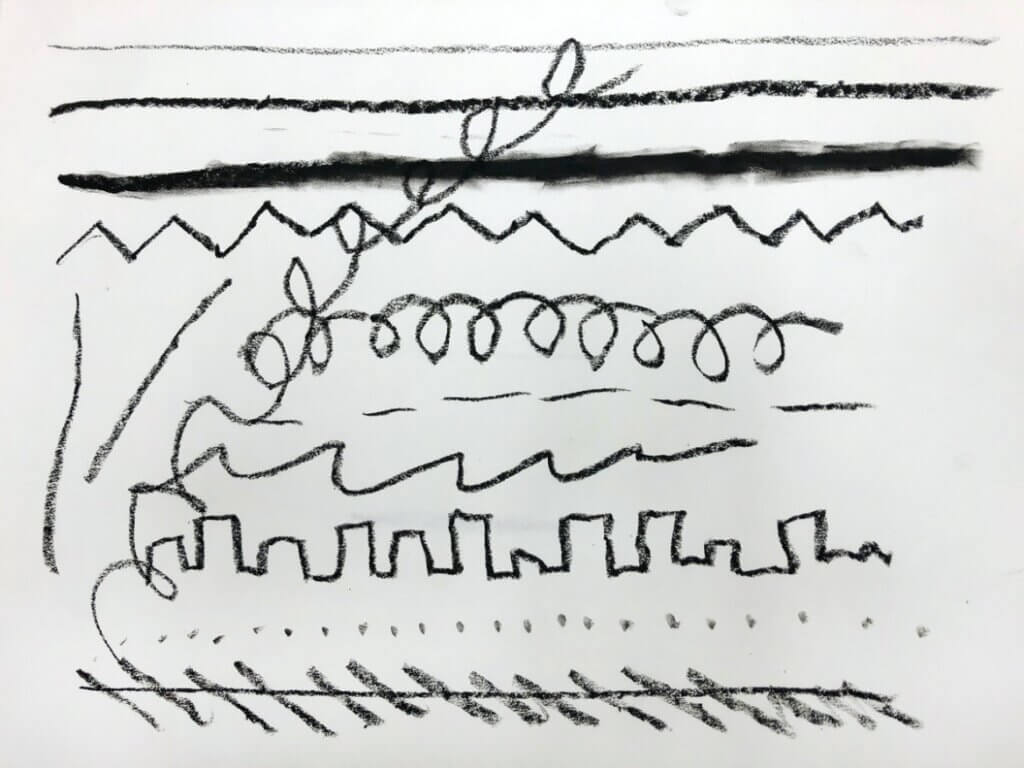Overview
Line and Mark Exploration
In this lesson, you will explore a new drawing tool—oil pastels. What do you notice about them that is special? Do they remind you of any other art materials? Let’s explore them together.
Materials and Tools
- Set of oil pastels
- 9 x 12” paper
- Paper towel
Activities

- Open your oil pastels. What do you see in the box?
- What colors do you see?
- Pick one up. Look closely. What shape is it, how does it feel?
- What are these called? They are called oil pastels. I wonder why they are called oil pastels? (There is oil mixed with the wax and pigment.)
- Do they remind you of other art materials? (crayons, for example)

- What do you think we can do with oil pastels? We can make lines and marks.
- Try a few lines and marks with your finger in the air.
- Choose the black oil pastel. Keep the others in the box.
- Make some lines and marks on the paper.
- What happens when you press down hard?
- What happens when you press lightly?
- Put the oil pastel back in the box! How do you think can we change these lines with our fingers?
- With your finger, press down and across the line—what happened? You smeared or smudged the lines!

- Make as many marks and lines as you can with the black oil pastel!
- Can you make them crossover each other, next to each other, etc.
- When you’re done, wipe your fingers off on the paper towel to clean them.
Prompts for Independent Art Making:
Try to make as many different lines as you can, using one color. You might try:
-Bumpy, wavy, zigzag, dotted, broken, wiggly, spiral
-What other lines can you think of?
-Can you make up your own lines?

There are lines everywhere! Go on a line hunt! Walk around your classroom or your home and see how many different lines you can find. Do any of them connect? See if you draw the lines you find. Use your oil pastels!
Look outside the window and see how many different kinds of lines you can find. Next time you leave school or your home, look for all the different lines in your neighborhood—on the street, on the sidewalk, on buildings? Or, in nature- what kinds of lines do you see in trees?
How do lines make us feel? Try to draw a line that feels exciting! What kind of lines seem sleepy, happy, or like they are dancing?
What if you put many lines next to each other? Can you make a line pattern?
Do you think a line can tell a story? What kind of story can it tell? What if the line changes as you draw it? What if you take a line for walk? Where will it go? Where will it start? Where will it end?
Artists for Inspiration:


What kind of lines does each of these artists use? Can you describe them? How do you think they made these lines?
Reflection Questions
- What kind of lines did you make? Which ones do you like best?
- How was drawing with oil pastels different from other drawing materials you’ve used (pencil, marker, crayon?)

Vocabulary
Oil pastel, oil, color, smudge, smear
Lines—straight, bumpy, wavy, zigzag, dotted, broken, wiggly, spiral
Resources
Books:
The Line by Paula Bossio
A Line Can Be by Laura Ljungkvist
The Straight Line Wonder by Mem Fox

